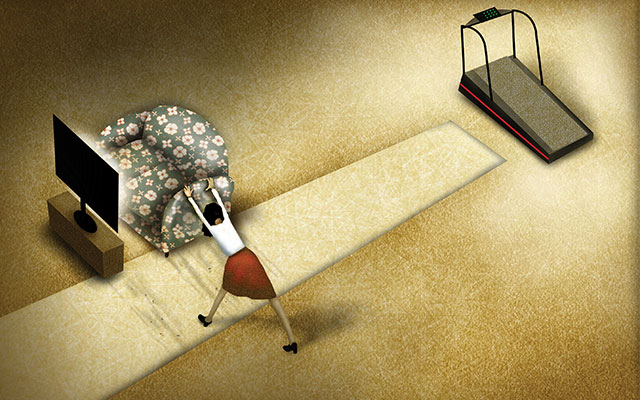You’ve just arrived home after a long day at work. The evening’s activities are clear in your mind: a good workout; a relaxing, healthy meal; then catching up on some bill paying. You walk in the door, kick off your shoes — and plop down on that super-comfy, overstuffed sofa in front of the big screen in the living room.
An hour later, your growling stomach (or your family) reminds you there’s dinner to prepare, so you head to the kitchen — snatching a handful of cereal from one of the boxes that line the back of the countertop. You open the fridge and quickly spot the leftovers from yesterday’s takeout. A few moments later, tonight’s meal (albeit not the one you had in mind) is warming in the microwave.
After dinner, you succumb to the lure of the couch once again, ignoring the pile of bills and junk mail on the kitchen island and diverting your gaze from the treadmill in the adjacent den. Heading off to bed later, you realize another day has passed without taking any of the actions you were so determined to take before you walked through the front door.
Your home may be comfortable and inviting. It may even be beautifully decorated. But from a behavior-design standpoint, it could probably use a makeover.
Your Brain at Home
Brain researchers and psychologists know that our unconscious (or implicit) memory systems detect and respond to patterns and cues from our surroundings that we may not consciously notice. This means that our environment — whether work, school, or home — plays a huge part in how we feel and what we do.
The vast majority of our behaviors (as much as 95 percent, according to some studies) are driven by our unconscious mind. In other words, we run on autopilot most of the time. This is the working of what I refer to as our “fast” brain — the myelinated neural networks of our habitual behavior. (For more on this, see “Relapse Recovery“.)
We also have a conscious “slow” brain. It’s what we use to solve problems, make decisions, or exert willpower.
Our fast brain is actually quite helpful; it’s efficient and functions amid overwhelming choices in our hectic world. It shifts most of our actions into a kind of “autopilot” mode so we don’t burn precious cognitive fuel puzzling over problems we already know how to solve (like how to get to and from work each day). But when our environment encourages undesired automatic behavior, our fast brain doesn’t do us any favors. In fact, it’s often primed to act against our stated intentions.
Priming is the phenomenon in which something in our environment triggers fast-brain shortcuts, or heuristics, stored within our implicit memory. When we are exposed to certain cues, we behave in certain predictable ways.
Most of us are familiar with priming via conscious triggers, such as a text that prompts us to call a friend, a notification on a computer screen that tells us to go to a meeting or check our email, or the alarm that wakes us in the morning. But at home, we often become blind or unconscious to triggers that prime our behavior in ways that undermine our good intentions.
Designing Your Trigger Field
Unconscious triggers in your home can sabotage you. That comfortable sofa and big screen invite you to “come on, sit down” — even if you were on your way to the treadmill in the den. The greasy takeout containers front and center in the fridge promise easy preparation, while the veggies you purchased yesterday (using your thoughtful slow brain) sit forgotten in the crisper. The stack of mail warns, “It will take forever to sort me out. Run away!”
And those cereal boxes? Cornell University researchers found that people who stored cereal boxes on their kitchen counters weighed 20 pounds more, on average, than those who kept them in cabinets.
But what if you designed your living space in ways that triggered your brain to unconsciously choose healthier behaviors? How could you create home systems that prompt your fast brain to choose actions your slow brain wants you to do?
Even small changes can make a big difference. You might place a $20 bill next to that stack of bills to prime yourself to feel abundant and in control. Or buy a clock that chimes pleasantly, reminding you to breathe deeply. And if replacing your comfy living-room couch with a treadmill seems a bit drastic, you might simply keep a set of dumbbells on the couch where you normally sit so you have to move them — and maybe do a few reps.
You could also design more dramatic changes, like investing in a new fridge with compartments that showcase healthy foods and make it harder to access unhealthy fare. Or plant a garden so you have a reason to spend more time in nature.
We are not slaves to our fast brains. Take a look at your living space with the fresh eyes and creativity of a designer and go beyond décor! Design the organization and placement of objects in your home to promote the behaviors you want to practice.
How to Use Behavior Design
Here’s an exercise to help you identify behavior-design ideas you can incorporate at home.
Step 1.
Think about a behavior change you really want to make. Perhaps you want to read more, get more sleep, or start cooking at home. Write it down. Then ask yourself a few questions about your living space.
- Where in your home (a room or a specific area of a room) would you practice this behavior?
- What time of day and how often would you want to do this?
- What other related actions — things you would do before or after your new behavior -— need some design support?
Step 2.
Now think about how you could design your space to support the behavior you want to change.
- What triggers could you install in your home that would get your attention? (Idea: Move bookshelves from the den to the living room.)
- How can you change your space to make it easier to adopt the behavior? (Idea: Take the TV and computer out of your bedroom.)
- How can you test your design to see if it works and adjust it if it doesn’t? (Idea: Pick a one- to two-week period to try it out; record the results, including how the change makes you feel.)
Remember that all designs expire and need to be updated or refreshed. Just like you get tired of (or stop noticing) the color of a wall, your brain will eventually ignore the design triggers you set. Just keep on designing!
This article originally appeared as “Behavior Design at Home” in the April 2016 issue of Experience Life.




This Post Has 0 Comments